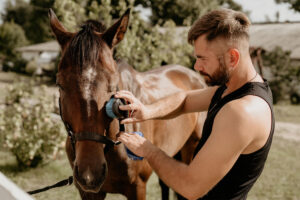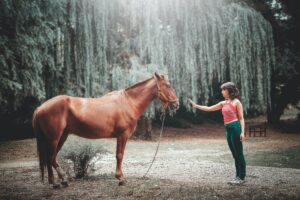
Equine vocalizations encompass a wide range of sounds produced by horses, serving as an integral part of their communication repertoire. These vocalizations allow horses to express their emotions, convey messages, and interact with other members of their herd. Understanding equine vocalizations is essential for horse owners, trainers, and enthusiasts as it can provide valuable insights into the horse’s well-being and state of mind.
One of the most recognizable equine vocalizations is the neigh or whinny, a loud and high-pitched sound often associated with excitement or communication over long distances. Horses may neigh to announce their presence, express greetings, or seek attention from both humans and other horses.
Another common vocalization is the nicker, which is a softer and lower-pitched sound that signifies contentment, anticipation, or a friendly greeting. The nicker is often described as a gentle rumble or murmur and can be heard when horses are being fed, interacted with, or in the company of familiar individuals.
Horses also use snorts as a means of communication. A snort is a forceful exhalation of air through the nostrils, accompanied by a vibrating sound. Snorting can express surprise, alertness, or serve as a release of tension. It is often observed when horses encounter something unfamiliar or potentially threatening.
Squealing is another vocalization commonly associated with horses. It is a high-pitched, shrill sound that horses produce when they are displeased, agitated, or excited. Squeals are frequently heard during social interactions or when horses are competing for resources within a group.
In situations where a horse experiences discomfort, pain, or stress, it may emit a groan. This vocalization is characterized by a low and deep sound and is often associated with physical exertion or moments of discomfort. It serves as a signal for horse owners and caretakers to investigate and address the underlying issue.
Stallions, in particular, can produce distinct vocalizations during mating behavior or territorial disputes. Roaring or bellowing is a powerful and resonating sound that stallions use to establish dominance or attract mates. This guttural vocalization conveys strength and dominance within the herd or during breeding encounters.
Lastly, the whicker is a soft and breathy vocalization that horses use to express curiosity or communicate with other horses. It is commonly heard when a horse is seeking attention, anticipating interaction, or expecting a treat.
It is important to recognize that equine vocalizations can vary in intensity, duration, and frequency depending on individual horses, their personalities, and the context in which they are produced. By paying attention to these vocal cues, horse enthusiasts can deepen their understanding of equine behavior and strengthen their bond with these magnificent creatures.
- Neighs: Neighs are perhaps the most recognizable vocalizations produced by horses. These versatile sounds can convey a wide range of emotions, such as greetings, calls for attention, or expressions of distress. Learn to differentiate between the variations in pitch, duration, and intensity to interpret the underlying message behind a horse’s neigh.
- Whinnies: Often associated with excitement or anticipation, whinnies are high-pitched vocalizations that carry across distances. Horses use whinnies to communicate with their herd members, express their presence, or search for companionship. Delve into the nuances of whinnies and decode the emotions horses convey through these distinctive sounds.
- Snorts and Blows: Snorts and blows are short, forceful bursts of air expelled through the nostrils. These sounds serve multiple purposes, such as expressing curiosity, alertness, or even defiance. Gain insights into the different types of snorts and blows horses produce and their significance in various situations.
- Squeals and Screams: Squeals and screams are intense, high-pitched vocalizations horses emit during moments of extreme excitement, fear, or aggression. By understanding the context and accompanying body language, you can discern the underlying emotions and respond appropriately to ensure safety and well-being.
- Nickers and Nibbles: Nickers are soft, low-pitched sounds often associated with positive interactions and greetings between horses. They are gentle expressions of affection, camaraderie, or reassurance. Explore the different types of nickers and nibbles horses use to bond and establish social connections.
- Groans and Grunts: Groans and grunts are lower-pitched vocalizations that horses produce during physical exertion or discomfort. These sounds can indicate pain, effort, or dissatisfaction. Learn to recognize the subtleties in groans and grunts, enabling you to address any potential issues promptly and ensure your horse’s well-being.
Conclusion: Equine vocalizations provide a window into the rich and intricate world of horse communication. By familiarizing yourself with the various sounds horses make and their meanings, you can better understand their needs, emotions, and intentions. This glossary of equine vocalizations equips you with the knowledge to enhance your horsekeeping skills, strengthen your bond with your equine companion, and deepen your appreciation for the remarkable language of horses.






